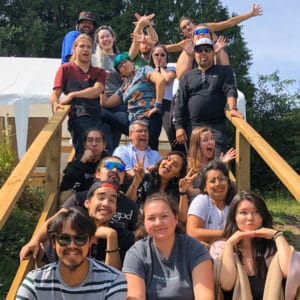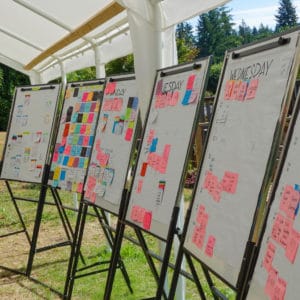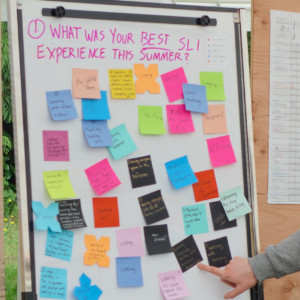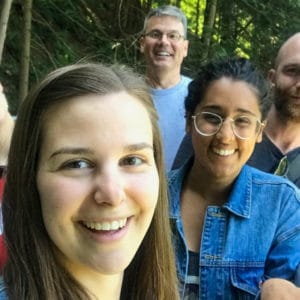 I was first acquainted with WAYK in 2015, attending a Lingít language circle put on at the University of Alaska Anchorage. I really liked the technique as a way to make language learning fun and to facilitate immersion in a language circle setting. After being introduced to WAYK, I worked at the Alaska Native Heritage Center (ANHC) in Anchorage. At ANHC, we held Iñupiatun language classes once, or twice a week, for an hour and half, with students of all ages. Often we would “split the cell” (a WAYK technique meaning to split into two or more groups), where children would be in one class, while adults would be in another. One of the goals of the classes was to get students interested in language learning to the point where they could also transition to becoming teachers themselves. My good friend, Annauk Pollock, is an example of a student who after a year, transitioned to being a teacher.
I was first acquainted with WAYK in 2015, attending a Lingít language circle put on at the University of Alaska Anchorage. I really liked the technique as a way to make language learning fun and to facilitate immersion in a language circle setting. After being introduced to WAYK, I worked at the Alaska Native Heritage Center (ANHC) in Anchorage. At ANHC, we held Iñupiatun language classes once, or twice a week, for an hour and half, with students of all ages. Often we would “split the cell” (a WAYK technique meaning to split into two or more groups), where children would be in one class, while adults would be in another. One of the goals of the classes was to get students interested in language learning to the point where they could also transition to becoming teachers themselves. My good friend, Annauk Pollock, is an example of a student who after a year, transitioned to being a teacher.
As a member of the language revitalization team at ANHC, I was lucky enough to be involved in three WAYK trainings. I learned a lot about the method during these trainings, and its potential for increasing true immersion time in language learning was really exciting to me. But of course, WAYK is not the only language learning method out there, and I wondered about how other methods could be incorporated next to WAYK in our classes.
At ANHC, we were lucky enough to also have trainings in the Accelerated Second Language Acquisition (ASLA) method and Total Physical Response (TPR), as well as assessment trainings from the University of Oregon. Furthermore, we developed many songs, games, dances and other immersion activities. How can you as a teacher fit all of these types of language techniques and activities in with each other in a way that is intentional and also not too overwhelming for learners? That’s the question I hope to explore in this blog: How can WAYK be best layered with other techniques and activities?
One thing I appreciate about Evan and Susanna’s approach is that although they love WAYK, they make sure people know there are other techniques and resources out there and they encourage people to take advantage of them. In working with my colleagues to build a Iñupiatun teaching and learning curriculum in Anchorage, we had to consider how to best put these varied types of methods together in one curriculum. A good way to think about layering different techniques is to consider what aspects of the different methods make the most intuitive sense for different aspects of grammar.
WAYK, for example, is really strong for practicing question and answer dialogue. (i.e., “Is this a rock?” “Yes, it is a rock.” “Is this your rock?” “No, this is not my rock, this is his rock,” and so on.) I think this is particularly true for asking questions in the 2nd person and answering in the first person. (For example: “Are you hunting?” “Yes, I am hunting.” “What are you hunting?” “I am hunting moose,” and so on).

Methods like Rosetta Stone or the ASLA method, in my opinion, are really good for introducing vocabulary for the first time (giving the learners a 3D or 2D representation of the vocabulary) and also for practicing third person questions. (For example: “Is he hunting?” “Yes, he is hunting.” “What is he hunting?” He is hunting moose.” And so on.) WAYK can be good for 3rd person as well, but I find that sometimes it can be confusing about who you are talking about, whereas with an image, like in ASLA or Rosetta Stone, it is always clear that you are talking about a 3rd person rather than yourself.
Lastly, TPR is really great for teaching commands and for reinforcing already learned vocabulary. For example, “Go hunting.” “Hunt the rabbit.” “Hunt the moose,” etc. Below you can find a table of how one could potentially layer several different methods to reinforce the same vocabulary and grammar
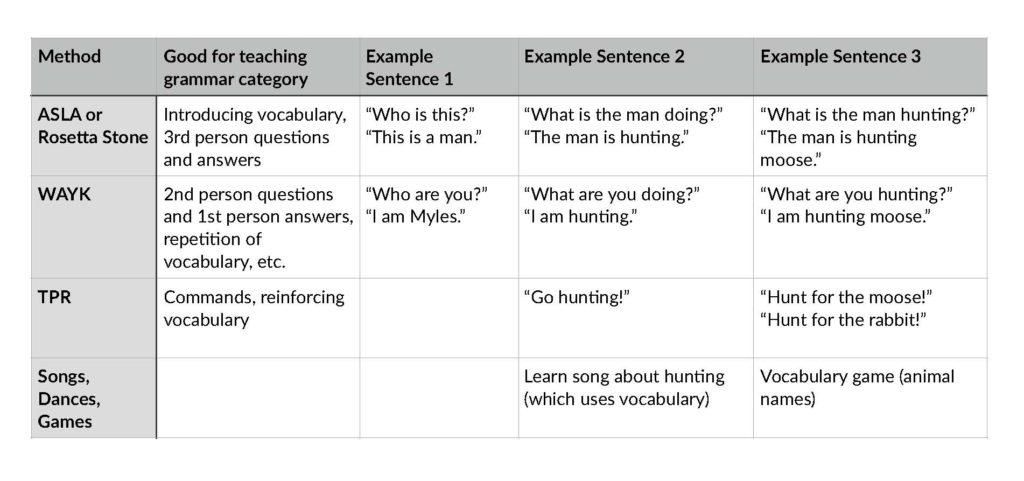
Obviously you will need to match the cultural protocol and the grammatical patterns of the target language you are learning (for example, some languages you would not presume to say you are hunting for a particular animal, or in some languages there are several different verbs for hunting, depending on the type of animal), but this is one example of how one could layer WAYK with other techniques that actually reinforce the grammar and vocabulary instead of learning something totally new unrelated to what you have just been learning. Of course, you can also separate activities using different immersion techniques by singing songs, playing games, and doing dances, either as a break for your mind or as a way to further reinforce you particular lessons.
There is no magic bullet to accomplishing your language goals, and layering techniques can keep things fresh for your learners and it can also bring success for different learning styles (i.e., kinesthetic learners might be more drawn to WAYK, auditory learners might be more drawn to TPR, and more visual learners might key in more to ASLA/ Greymorning). I would recommend those who are developing immersion learning programs to consider multiple different techniques, but make sure in your development of curriculum that you are layering the techniques so that they reinforce each other and make things easier for your students, rather than creating more roadblocks to learning.
Post authored by Myles.

